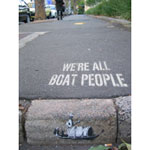video
Beware of the God
Like the U.S., Australia has a growing problem of fundamentalists in politics.
In response, graphic designer, artist, and activist Deborah Kelly has undertaken a large scale public art project in the streets (skies and train stations) of Sydney. From bewareofthegod.com:
“This site intends to be a resource of diverse material documenting, analyzing, and musing upon the impacts and aspirations of religious literalists in the public sphere. It is being produced in Australia, in 2005, so that is its first focus. However, you will also find here information, ideas and reportage from other places, because even though context is everything, a global phenomenon is also something.”
The project incorporates multiple media, including:
A 30 second film shown every ten minutes on 42 billboard screens in Sydney train stations, viewable in miniature here [Quicktime 874 Kb]
Projections onto clouds over Sydney Harbor:
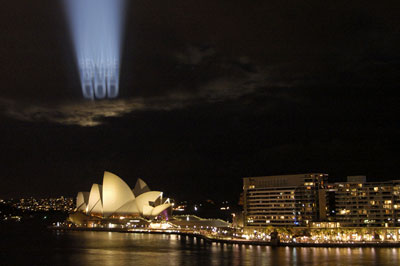
Distribution of 40,000 free postcard/stickers (you can mail or peel the front off and stick to your door.)

And essays and analysis posted on the project Web site. On the site is an open call for further cultural and analytical material.
The effort is backed by the Museum of Contemporary Art in Sydney as part of their biennial Contemporary Australian Art show, this year called Interesting Times.
Related projects from Kelly include a series of posters designed with Tina Fiveash satirizing the right wing regime of “compulsory heterosexuality”.

And a series of illustrated matchboxes satirizing the Christian right push in Australia to have muslim women and girls banned from wearing hijab “because they might be hiding bombs.” Kelly and friends made thousands of satirical matchboxes and left them lying around.
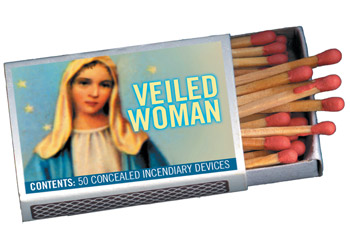
Kelly is also involved in a collective challenging the rhetoric of politicians calling refugees ‘boat people.’ See more at http://www.boat-people.org/
Though not aligned with a specific organizing campaign, I think such cultural work is important in the battle for hearts and minds.
Must See TV
After this weekend’s massacre in Uzbekistan, the government has sealed off the roads into Andijan.  Journalists were forcibly removed from the city and unable to return. Along with the news. The government is blocking Web sites and broadcasts into the country by foreign news channels including BBC World, CNN and Russian network NTV. The state run television has replaced domestic news broadcasts in the region with art movies, music clips, and nature photos.
Journalists were forcibly removed from the city and unable to return. Along with the news. The government is blocking Web sites and broadcasts into the country by foreign news channels including BBC World, CNN and Russian network NTV. The state run television has replaced domestic news broadcasts in the region with art movies, music clips, and nature photos.
It’s not the first time we’ve seen the arts used as a deliberate means of stifling political engagement.
It won’t be the last.
From the New York Times, May 15:
“Executives at National Public Radio are increasingly at odds with the Bush appointees who lead the Corporation for Public Broadcasting.
In one of several points of conflict in recent months, the chairman of the Corporation for Public Broadcasting, which allocates federal funds for public radio and television, is considering a plan to monitor Middle East coverage on NPR news programs for evidence of bias, a corporation spokesman said on Friday.
The corporation’s board has told its staff that it should consider redirecting money away from national newscasts and toward music programs produced by NPR stations.”
Over There
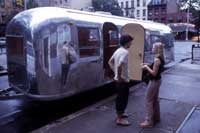 A cousin is in town selling ceramics out of an old jet stream he converted into a nomadic gallery. The Museum of Art and Design (formerly the Crafts Museum) across from the Museum of Modern Art helped arrange a parking space and circulated a press release. This brought New York One, a local cable news channel, to the scene where they filmed a bit in the morning to broadcast a brief story shortly after.
A cousin is in town selling ceramics out of an old jet stream he converted into a nomadic gallery. The Museum of Art and Design (formerly the Crafts Museum) across from the Museum of Modern Art helped arrange a parking space and circulated a press release. This brought New York One, a local cable news channel, to the scene where they filmed a bit in the morning to broadcast a brief story shortly after.
Later that day, passersby gush at the site of the trailer, “Hey! I saw you on the news!”
Their surprise surprises me. If the news supposed to tell us what’s going on, why the surprise when one actually encounters it? Is it just the happy recognition of a celebrity spotting? Or something else? Does the mainstream media, which supposedly shows you the world, also disconnect you from it? Aside from the weather, is the news is always happening somewhere else to someone else?
Bush Party Mix
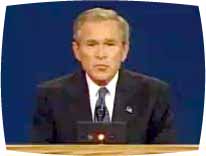
In their own words — some short, grassroots, video remix analysis of the debate, the RNC, and the media:
Have there ever been this many independent feature length films and video shorts produced for an election? I predict we’ll see even more in the next one.


